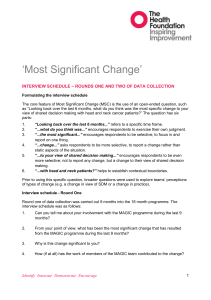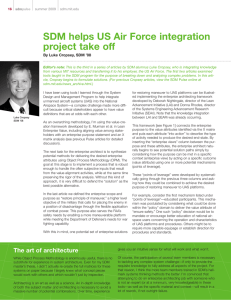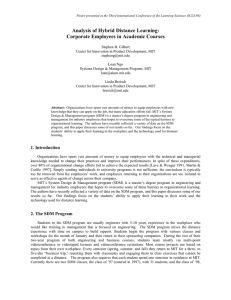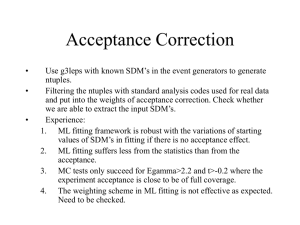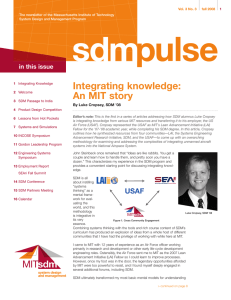Integration project puts SDM lessons to work By Luke Cropsey, SDM ’08
advertisement
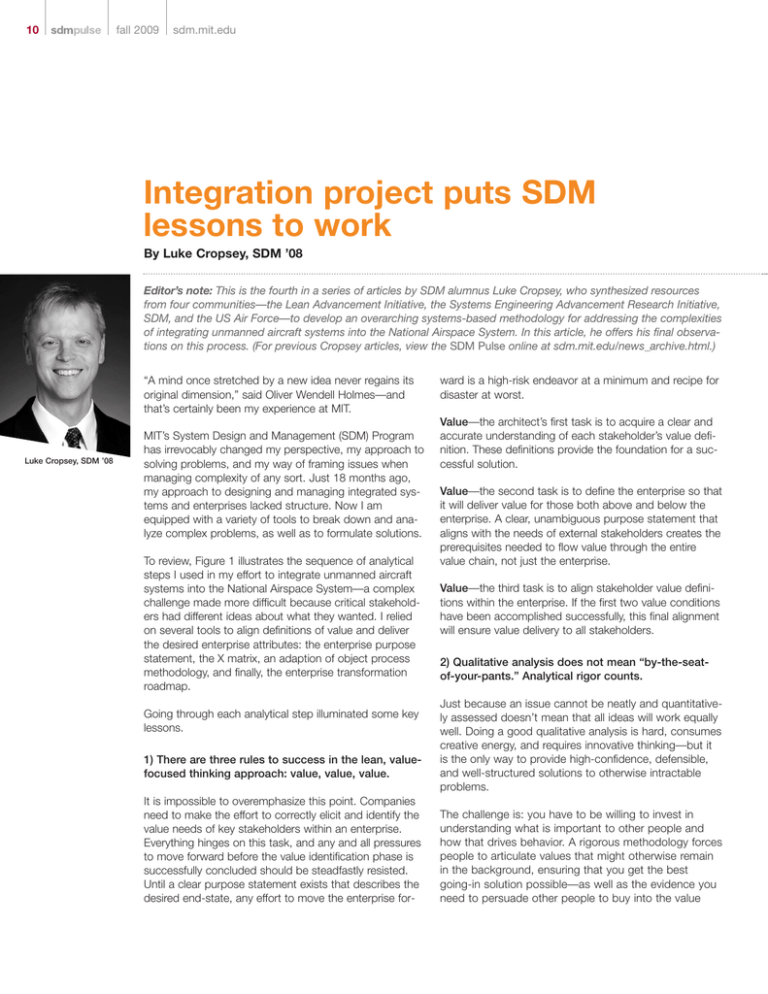
10 fall 2009 sdm.mit.edu Integration project puts SDM lessons to work By Luke Cropsey, SDM ’08 Editor’s note: This is the fourth in a series of articles by SDM alumnus Luke Cropsey, who synthesized resources from four communities—the Lean Advancement Initiative, the Systems Engineering Advancement Research Initiative, SDM, and the US Air Force—to develop an overarching systems-based methodology for addressing the complexities of integrating unmanned aircraft systems into the National Airspace System. In this article, he offers his final observations on this process. (For previous Cropsey articles, view the SDM Pulse online at sdm.mit.edu/news_archive.html.) “A mind once stretched by a new idea never regains its original dimension,” said Oliver Wendell Holmes—and that’s certainly been my experience at MIT. Luke Cropsey, SDM ’08 MIT’s System Design and Management (SDM) Program has irrevocably changed my perspective, my approach to solving problems, and my way of framing issues when managing complexity of any sort. Just 18 months ago, my approach to designing and managing integrated systems and enterprises lacked structure. Now I am equipped with a variety of tools to break down and analyze complex problems, as well as to formulate solutions. To review, Figure 1 illustrates the sequence of analytical steps I used in my effort to integrate unmanned aircraft systems into the National Airspace System—a complex challenge made more difficult because critical stakeholders had different ideas about what they wanted. I relied on several tools to align definitions of value and deliver the desired enterprise attributes: the enterprise purpose statement, the X matrix, an adaption of object process methodology, and finally, the enterprise transformation roadmap. Going through each analytical step illuminated some key lessons. 1) There are three rules to success in the lean, valuefocused thinking approach: value, value, value. It is impossible to overemphasize this point. Companies need to make the effort to correctly elicit and identify the value needs of key stakeholders within an enterprise. Everything hinges on this task, and any and all pressures to move forward before the value identification phase is successfully concluded should be steadfastly resisted. Until a clear purpose statement exists that describes the desired end-state, any effort to move the enterprise for- ward is a high-risk endeavor at a minimum and recipe for disaster at worst. Value—the architect’s first task is to acquire a clear and accurate understanding of each stakeholder’s value definition. These definitions provide the foundation for a successful solution. Value—the second task is to define the enterprise so that it will deliver value for those both above and below the enterprise. A clear, unambiguous purpose statement that aligns with the needs of external stakeholders creates the prerequisites needed to flow value through the entire value chain, not just the enterprise. Value—the third task is to align stakeholder value definitions within the enterprise. If the first two value conditions have been accomplished successfully, this final alignment will ensure value delivery to all stakeholders. 2) Qualitative analysis does not mean “by-the-seatof-your-pants.” Analytical rigor counts. Just because an issue cannot be neatly and quantitatively assessed doesn’t mean that all ideas will work equally well. Doing a good qualitative analysis is hard, consumes creative energy, and requires innovative thinking—but it is the only way to provide high-confidence, defensible, and well-structured solutions to otherwise intractable problems. The challenge is: you have to be willing to invest in understanding what is important to other people and how that drives behavior. A rigorous methodology forces people to articulate values that might otherwise remain in the background, ensuring that you get the best going-in solution possible—as well as the evidence you need to persuade other people to buy into the value 11 Figure 1. Overview of method and tools proposition that is created at the enterprise level. 3) Insight and innovation occurs at the intersection of dissimilar bodies of knowledge. This is by no means an original flash of brilliance on my part. Both Professors Eric von Hippel and Thomas Allen discuss the dynamics of this effect in their respective courses at MIT. Indeed, MIT’s Engineering Systems Division (including SDM) pools talent from across the engineering and management disciplines precisely because that fosters innovative approaches to old and new problems alike. Nevertheless, the truth of the observation struck me as never before as I worked through my analysis for the US Air Force. The combination of different approaches, tools, and perspectives laid the foundation for true insight into how to architect a solution for the unmanned aircraft systems airspace integration problem that had eluded me for two straight years working the problem in my day job. The difference stems from having an intentional process by which to bring together dissimilar bodies of information in a controlled manner. Too often organizations are satisfied with an almost random or haphazard level of innovation. But without a structured process, dissimilar bodies of knowledge will typically collide rather than intersect. One of the long-term benefits of SDM, which I am only now just beginning to appreciate, is the fundamental shift in the way that I think about innovation. SDM provides > continued on page 12 12 fall 2009 sdm.mit.edu Integration project puts SDM lessons to work > continued from page 11 the tools and methodologies needed to successfully integrate disparate bodies of knowledge into efforts that will consistently yield innovation opportunities. Notice I said “opportunities.” This is not to say the next “killer app” can be reduced to a series of repeatable steps. However, with the right tools, methodologies, and mindset, it is possible to create an environment in which innovation can thrive and grow instead of showing up by accident. This is the most valuable lesson I learned from working at the intersection of the LAI, SEAri, SDM, and The Air Force bodies of knowledge in my research. In the final analysis, it was the synthesis of these four perspectives into an integrated methodology that paved my way forward. Integrating knowledge SDM provided the systems thinking imperative, management tools, and architecting framework to crank through the mechanics, making everything work together to produce the desired results. However, it would be a mistake to think that rigor can create a completely objective view of the squishy, softedged problems that are typical of today’s complex socio-technical systems. Rigor can induce repeatability into the process, but not objectivity. At the end of the day, much of the system and enterprise architecting work that is at the heart of the research I’ve presented is still very much an art form. As with most complex undertakings, there is no substitute for experience. USAF Eight months after graduating, I find myself digging into the MIT tool bag on an almost weekly basis. The SDM way of thinking keeps finding new outlets for expression—even now that my job no longer has anything to do with unmanned aircraft systems. Figure 2. Cross-community engagement Each of the above-mentioned organizations made key contributions to my research in ways that were both distinct in nature and that built on the strengths of the others (see Figure 2). The Lean Advancement Initiative taught me the importance of value definition. No matter what the context or the nature of the task at hand, properly identifying what is of value to those involved is always the first step to success. The Systems Engineering Advancement Research Initiative provided the needed methodological rigor and practice for me to move beyond an ad hoc application of enterprise architecting principles and to implement a full, systematic approach grounded in solid research techniques and principles. The US Air Force, my employer, demanded practical, implementable results, which kept the “so what” of this research constantly at the forefront of my mind. It used to be that when people asked me what I did, I would tell them I was an engineer. Now I borrow a line from Professor Edward F. Crawley and tell them I manage complexity, reduce ambiguity, and focus creativity—in short, I architect solutions to problems. Oliver Wendell Holmes knew what he was talking about.
